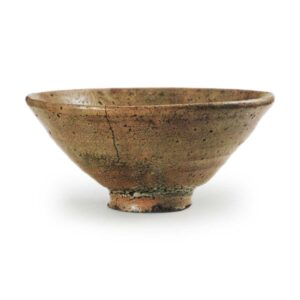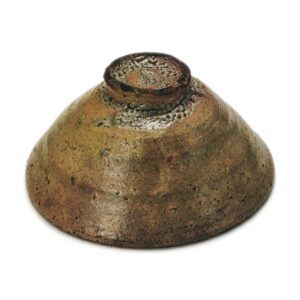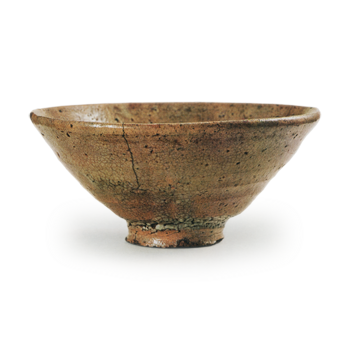

Name: Hachiya Ido
Height: 6.8 – 7.2cm
Diameter: 15.2cm
Height of foot ring: 4.9 – 5.1cm
Height of rim: 1.3cm
In the Taisho Meiki Kan (A Guide to Famous Tea Bowls from the Taisho Period), this tea bowl is referred to as an old well, but there are probably many people who have doubts about the fact that the Shibata well, which has a glaze color almost identical to this one, is referred to as a blue well. If the Uji well is an old well, then the Shibata well must also be an old well. If the word “old well” is used to mean a small well in contrast to a large well, and the small character is used to avoid the word “old”, then it is only natural to call a well like Shibata or Uji a small well, but for the sake of convenience, both are referred to as “blue wells” here. As you can see by following the illustrations in order, the range of Aoido is not limited to the blue color of the glaze, but also includes forms that, while deviating somewhat from the literal meaning of the word, are also included.
Incidentally, it is not clear when Shibata was first called Aoido, but when it was used by Roka Hirase in April 1898, it was written “One bowl, Aoido, received from Nobunaga by Katsuie Shibata”, so it is certain that it was already called Aoido when it was in the Hirase family. However, in the case of the Uji well, the owner, Kobe Sokawa, wrote in the accompanying note “Uji Well Appreciation” that “… (omission)… it is truly the best of all small wells” in 1784, , in 1916, Kobe Ginshu, who had given it to Oda Tokubei, wrote in the transfer document that it was “the Aido owned by Lord Uraku, famous for its name of Uji”, and so what was a Koido in 1781 became an Aido in 1916.
From the above, it can be seen that the distinction between koido and aoido became a popular topic of debate among tea masters such as Toda Rogen and Hirase Roka, especially after the tea master Fumai, and the fact that such a distinction is almost never seen in old box inscriptions it seems that until the late Edo period, old wells, blue wells and large wells were all treated as well-made tea bowls, and if they were to be distinguished, they would be treated as small wells (including blue wells) in comparison to large wells.
The characteristics of this tea bowl are that it is full of variety in terms of the way it was made and the glaze, and it is said that Oda Uraku named it after a tea bowl from Uji in Kyoto because it has many points of interest. The inside of the bowl has a concave section for the tea, and the way the glaze changes from the middle of the bowl , and the rich color of the glaze from the foot to the outside is also superb, especially the reddish loquat-colored glaze and the kaaragi (Japanese apricot bark) inside and outside the foot, which have a deep flavor that surpasses the morning scenery of the famous place Uji.
The origin of the tea bowl is said to be in the possession of Oda Uraku, as the author of the small paper label that was thought to have been attached to the inner box is referred to as “Uji Ido Uraku Shofutsu” in the “Meibutsu Mekiribunsho” (Famous Tea Bowl Appraiser’s Book), and it is said that it was later passed on to Hachiya Hikobei of Kyoto, and was therefore also known as the Hachiya Ido for a time. Later, it became the property of the tea master Bunsaiemon Kobe of Nagoya, and in 1916 it was passed on to Tokubei Oda of the same area, and then passed on to the Nakamura family.



